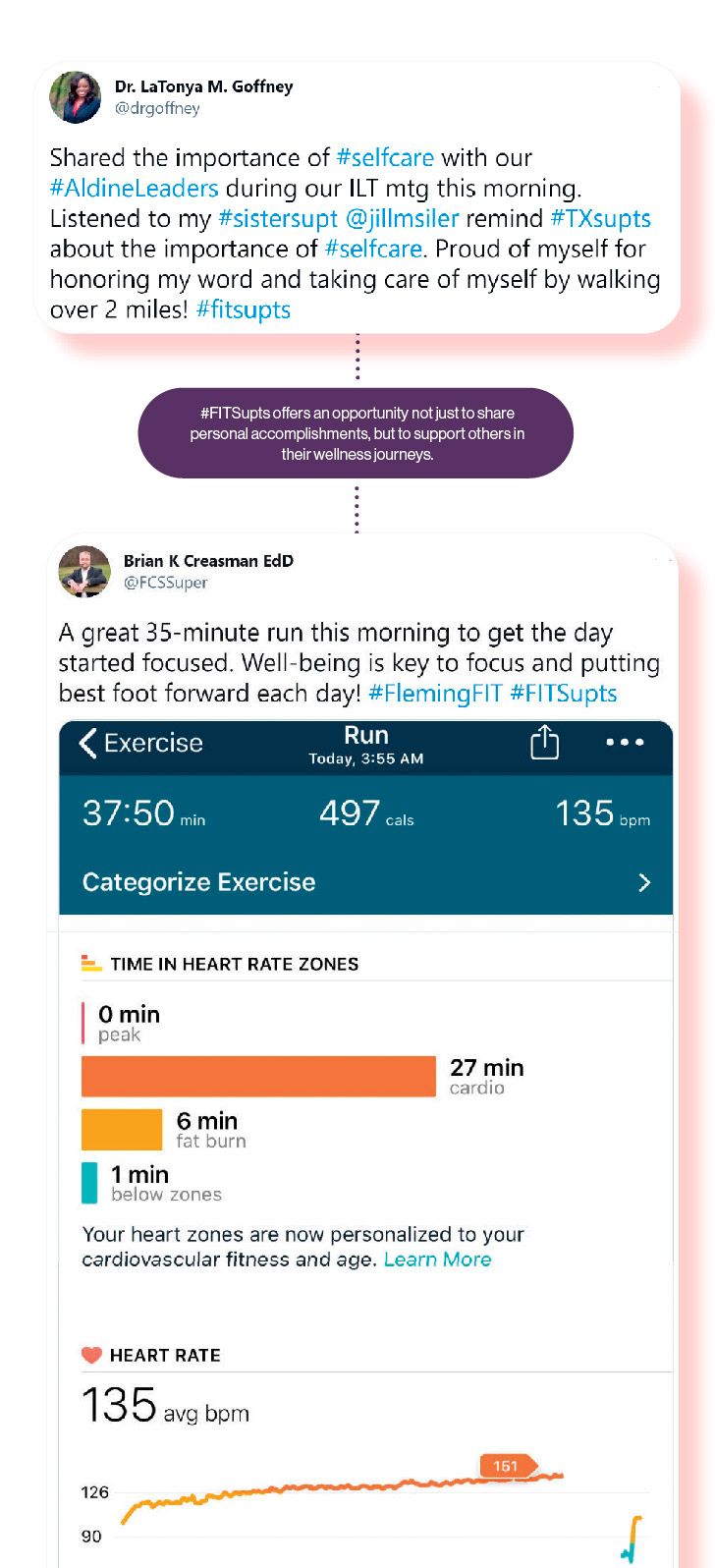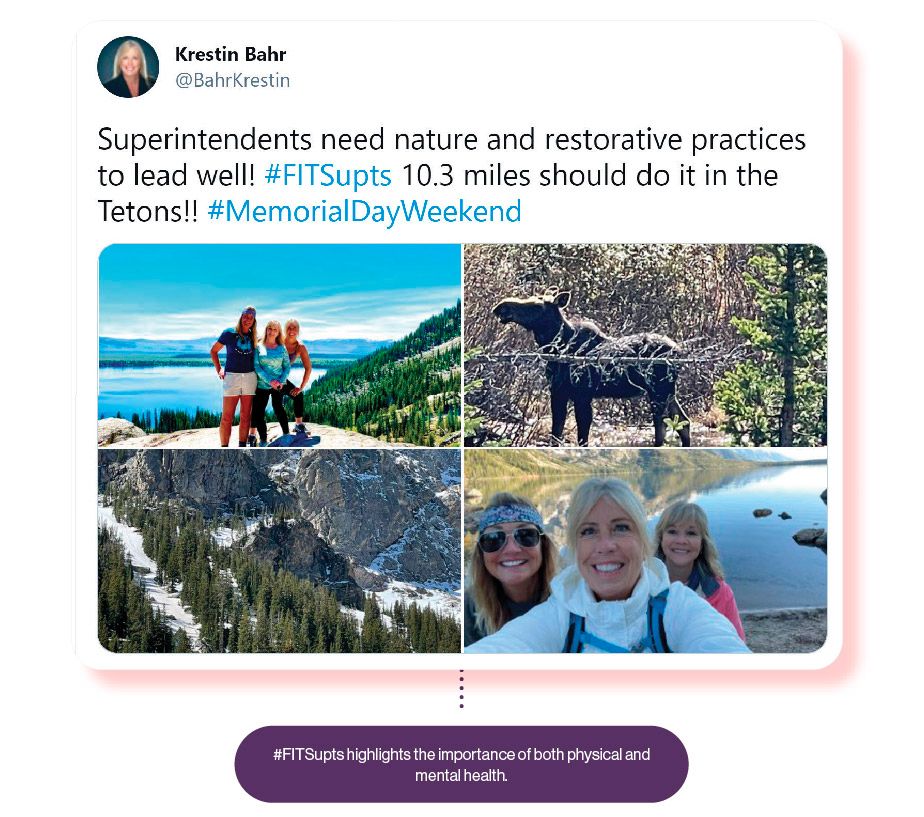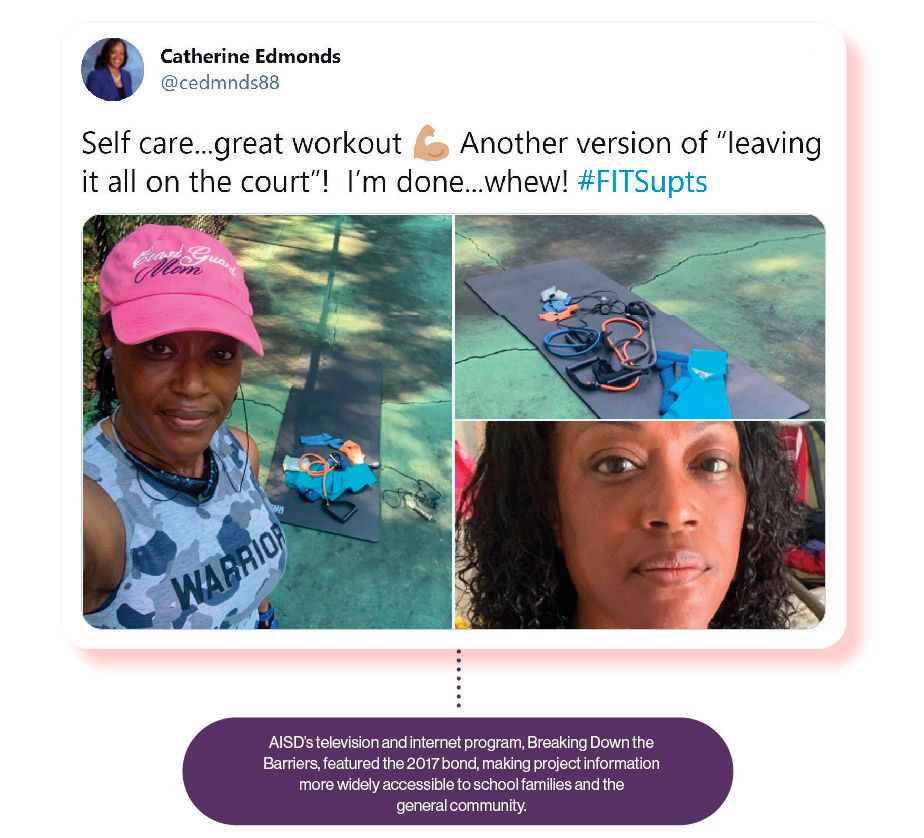Dr. Brian Creasman: Fit to Lead
Through #FitSupts, Dr. Brian Creasman shares the transformative power of wellness for life and leadership.

Throughout my career, like thousands of other school leaders, I have regularly worked long hours. As a high school administrator, I developed gout in my feet and even visited the emergency room twice with heart issues due to the stress of my 80-plus hour workweeks. During my first year as a superintendent, I gained unwanted weight, started experiencing knee problems, and caught more colds than normal—all related to stress.
For years, I took an on-again, off-again approach to my overall health and well-being. I’d occasionally work out for a month or two, then stop when things got busy. I never truly understood how my wellness impacted my effectiveness as a leader.
After losing my father to a stroke in 2019, I knew I had to make a change. He had experienced multiple strokes before his death, and my mother also suffers from several medical conditions. I knew that although I couldn’t change my family medical history, I could change my lifestyle.
I wish I could say that I have always liked to work out, watch what I eat, and stay physically active. But making my wellness a priority has been an acquired passion, one that’s taken a lot of concentration and commitment. In January 2020, I started running on a treadmill for just five minutes at a time. Now, I’ve worked my way up to 45-minute runs, four times a week. Some mornings, I still don’t really want to work out. Some days, it’s too much. But I know that if I don’t squeeze in my workout, I’ll be struggling by the end of the day—not just physically, but mentally.
For me, well-being has never been about developing a six-pack core or massive biceps; it’s all about finding a work-life balance. Like so many other school leaders and educators, I let my health take a back seat for a long time—but not anymore. Since January 2020, well before COVID-19 made underlying health conditions a widespread concern, I’ve made wellness a major driving force behind my leadership.
#FITSupts
In December 2020, I posted a short message on Twitter encouraging school leaders to set an example by sharing their journeys toward better health. The tweet contained a simple hashtag: #FITSupts. That hashtag spread like wildfire overnight. The next morning, I woke up with nearly 400 more followers than I’d had the day before.
#FITSupts is a network of current and aspiring school leaders who have come to recognize the importance of wellness. Through each social media post, we bring attention to an issue that is often overlooked or simply ignored. While we recognize that the nuts and bolts of leadership are important, we take care to remember that our wellness is just as crucial.
Modeled after #FITLeader and #FITPrincipal, #FITSupts encourages educational leaders to share how they are taking care of their health. I try to post daily about my cardio and strength training. Other leaders post about their diets, the importance of sleep, ways to relax, or hobbies that help them clear their minds. Leaders who post on #FITSupts do not subscribe to fancy workout routines or “as seen on TV” weight loss gimmicks—just simple strategies that are transformative for the mind, body, life, and leadership.
#FITSupts is about accountability and education. As school leaders taking part in this movement, we hold ourselves accountable for our own well-being while teaching others how to do the same. Every educator struggles with maintaining a work-life balance and taking care of themselves. These posts not only offer an opportunity to highlight the struggle, but also connect leaders with others from across the country facing the same challenges. The journey to better wellness is a marathon, not a sprint, with many setbacks, obstacles, and detours. #FITSupts offers a glimpse into real leaders’ journeys and accomplishments—and gives us opportunities to support and encourage one another.
A Simple Message
The idea of #FITSupts stems from the fact that too many educators are leaving the profession due to burnout, exhaustion, or even stress-induced health problems. Too many of us retire only to live a confining life due to overall poor health.
Nothing is more important than our well-being. Students and staff need us to show up as our best selves each day. When we are stressed, depressed, and unhealthy, they also feel the negative impact. Likewise, when our staff members see us prioritizing our personal health and wellness, they will follow our lead.
We hold the key to our own health. Just as we spend countless hours discussing class sizes, teacher effectiveness, or financial contingencies, we must also dedicate significant time to our own well-being. Our students and staff need us to model the way for them. #FITSupts is part of that modeling.
We must change the conversation and decrease the number of educators leaving the profession because of burnout or poor health. Ultimately, by focusing daily on wellness, we aim to lower stress, reduce exhaustion, and help educators stay engaged.

It’s Okay
As superintendents, we are trained to show up at work each day and lead until the job is done. For most of us, the role is nonstop; though we take vacations, we’re never really away. To change that narrative, we must give ourselves permission to take time for personal wellness.
Too often, educators realize the critical importance of wellness only after an anxiety attack, a knee replacement, or even a near-death experience. As superintendents, we need to normalize taking time for our personal health. This is not to say we should abuse sick days or vacation time. In fact, if we make well-being a daily priority, we actually miss fewer days at work. We’re more productive, more engaged, and less stressed.
In my weekly message to staff, I provide strategies not only for educating students, but also for practicing self-care. Academics aren’t compromised when teachers prioritize their own wellness; in fact, when teachers are healthier, they are more effective, which leads to more positive outcomes for students. Nothing says that educators—regardless of what subject they teach—can’t shoot hoops, throw a Frisbee, or jump rope with students during gym or recess. Think about the positive impact these opportunities could have not just on educators themselves, but also on their relationships with students.
Just by thinking outside the box, educators can find multiple opportunities throughout the school day to squeeze in time for their health. Instead of sitting around a table for a PLC meeting, why not hold a mobile meeting and walk around the school building? Why not go for a stroll outdoors during a planning period to get some fresh air and Vitamin D? You could even invite staff to participate in a districtwide fitness challenge, where they can engage in physical activity through after-school aerobic sessions, walking clubs, running groups, or pickup basketball games.
Disconnect
With each passing school year, the need for school leaders to be connected to the job only grows. We often feel that we must always be accessible. We know all too well how an email at 9 p.m. can keep us up at night, throwing off our sleep patterns for days. We respond to texts or social media messages during breakfast, lunch, and dinner, never being truly present for our families. In essence, we have become victims of our own schedules and job descriptions. We are too connected, and that only leads to more pressure and stress.
As a 20-year veteran of education, I began my administrative career before smartphones and texting became integral parts of the job. As a young administrator, I only checked email a few times throughout the day—and I felt better back then. But after I upgraded to an iPhone as an assistant superintendent, I started checking my inbox nearly every 15 minutes and responding to texts almost instantly—while also responding to messages or posting on social media throughout the day.
Then, in November 2020, an automatic update disconnected my email from my phone. I tried everything I could to reconnect it with no luck. But after a couple of days, I quickly noticed how liberated I felt. Even now, I don’t have my school email on my phone, but I have not missed one important message—and I have more time for face-to-face communication.
There’s no doubt that communication is a key component of leadership—but we need to choose which communications to prioritize. To build stronger relationships both at work and at home, we must disconnect from technology and the pressures of the job more often.
Finding 20 Minutes
School leaders today are being pulled in so many different directions. Though the job has always been challenging, modern-day superintendents are dealing with rapid change, stagnant budgets, increased pressure for student achievement, and an alarming shortage of teachers and staff.
Each day begins with a deficit—it feels like we don’t have enough time in the day to do everything we need to do. Like all leaders, we often struggle to control our schedules. But if we don’t intentionally budget time for ourselves, the risk of burnout, stress, and long-term health problems only increases. No matter how packed our schedules are, we can all afford 20 minutes each day to focus on wellness.

As a superintendent, my day begins early in the morning and lasts well into the evening. If I am not careful, my schedule could push my mental and physical health down to the bottom of my daily to-do list. I could easily find an excuse each day not to find time to work out, breathe, or relax.
To make sure you get that 20 minutes, you must schedule it into your days. I prefer to reserve some time before work every morning to exercise; I like starting the day off focused. Plus, I’m probably the only one awake in the district, so there are fewer distractions. Others prefer to schedule that time after work as they decompress from their day.
Spending 20 minutes a day on yourself will lead to huge benefits in the long run. Just a little time each day jogging, walking, crafting, lifting weights, reading, journaling, or listening to music will lead to more energy and less stress.
When I don’t take any time to myself during the day, I feel disconnected from both work and my home life. I’m physically there, but my mind constantly wanders. Working out helps me focus not only on the key issues of my workday, but also on the more important things in life. Now, I can concentrate better at the office and be more present at home with my wife and seven-year-old daughter. It just takes 20 minutes.
One Last Thing
As school leaders, everything we do should benefit the students we serve—and that includes taking care of ourselves. After all, improved student wellness starts at the top. When we keep our health a priority, we are modeling the essential skills students need in order to grow into healthy adults.
As the 2020 Kentucky Superintendent of the Year, I’m often asked why I’ve made health and wellness my initiative. The answer is simple: Before we can actually focus on academic gains, we must first ensure that student well-being is a priority.
Too often, we undervalue wellness as a key educational component. This can have long-lasting negative effects on student health. But since the push for high-stakes testing began in the 1980s and early 1990s, opportunities for students to focus on their physical and mental health throughout the school day have decreased exponentially. Some school districts across the country do not have any health or physical education teachers. Furthermore, many schools have reduced or completely removed recess time.

According to research from the CDC, physical activity actually improves concentration and attention—key components of high academic performance. But in pursuit of higher test scores, we have phased exercise out of our school days, contributing to lasting health issues among our students and possibly even impeding their achievement. If we prioritize test prep sessions over opportunities to socialize, play, or engage in physical activity, are we teaching students that a test score is more important than a long, healthy life?
Students today have the chance to avoid the mistakes we sometimes make as adults: developing an unhealthy work-life balance full of stress, anxiety, and poor wellness. But as leaders, it’s up to us to show them the way. With COVID-19 came a new national emphasis on health. That means that we have an unbelievable opportunity to reengage our students in their journeys toward better well-being—and recommit to wellness ourselves. The key is to make time each day for our own health, so we can better lead and serve our school communities. See you online at #FITSupts!

SchoolCEO is free for K-12 school leaders. Subscribe below to stay connected with us!

